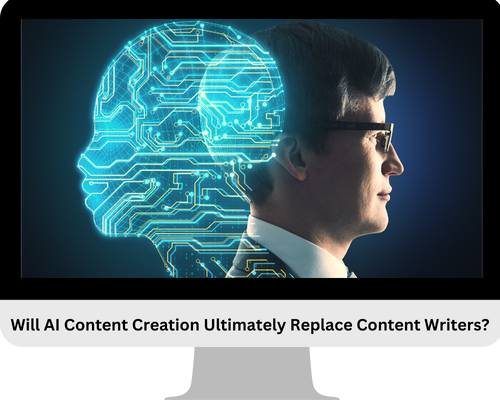Will AI Content Creation Ultimately Replace Content Writers?
Get in-depth information and AI’s Role in Content Writing

Will AI Content Creation Ultimately Replace Content Writers?
If you are a content writer, an AI content creation portal (especially if it is free) can be a nightmare for you. But is AI really a life-threatening challenge for content writers? In this article, we will explore the phenomena faced by content writers in the face of growing AI content creation challenge.
The rise of artificial intelligence (AI) technology has led to significant advancements in various industries, including content creation. AI technology is now being used to create written content, and some people are questioning whether AI content creation will ultimately replace content writers.

While AI technology has made significant progress in recent years, there are still several limitations to its capabilities. AI content creation can produce content quickly and efficiently, but it lacks the creativity, emotion, and nuance that humans can bring to writing. Here are some factors to consider when discussing whether AI content creation will replace content writers:
AI Content Creation’s Capabilities
AI technology has made significant strides in recent years, and there are now AI-powered content creation tools that can produce high-quality content. These tools use natural language processing and machine learning algorithms to create written content, such as news articles, product descriptions, and even social media posts.
AI content creation can be highly effective in creating simple, straightforward content, such as news articles or product descriptions. These types of content require a straightforward writing style and are primarily based on facts, figures, and data. In such cases, AI technology can produce content that is accurate, informative, and free of errors.
However, AI content creation has some limitations in terms of creativity, emotion, and nuance. Writing involves much more than just putting words together; it requires an understanding of context, tone, and emotion. While AI technology can analyze data to identify trends and patterns, it cannot replicate the creativity and unique perspectives that human writers bring to the table.
The Role of Human Writers
Human writers play an essential role in creating written content that is engaging, informative, and emotionally resonant. Unlike AI content creation, human writers can incorporate their unique perspectives, life experiences, and emotions into their writing, which makes the content more relatable and compelling.
Human writers can also understand the context and tone of a particular piece of writing, which allows them to create content that is appropriate for a specific audience. For example, a human writer can create content that is humorous, emotional, or persuasive, depending on the desired effect.
In addition, human writers can adapt to changes in a particular industry or topic area. They can conduct research, interview experts, and gain insights from personal experiences, which allows them to produce content that is informed and relevant. AI content creation, on the other hand, can only produce content based on existing data and trends.
The Future of AI Content Creation
While AI content creation has its limitations, it is still a rapidly evolving technology. As AI technology improves, it is likely that it will become more sophisticated and capable of replicating some of the qualities of human writing, such as creativity and nuance.
However, it is unlikely that AI content creation will ever completely replace human writers. Writing is a complex and nuanced art form that requires a deep understanding of language, culture, and human emotion. While AI technology can create simple, straightforward content, it cannot replicate the unique perspectives, life experiences, and creativity of human writers.
The Future of Writing
The future of writing is likely to involve a combination of AI technology and human writers. AI content creation can be used to produce simple, straightforward content quickly and efficiently, while human writers can create more complex, nuanced content that resonates with audiences on an emotional level.
In the future, AI content creation may be used to assist human writers in creating content. For example, AI technology can be used to generate ideas, conduct research, and provide feedback on the tone and style of a particular piece of writing. This would allow human writers to focus on the more creative and emotionally resonant aspects of writing.

What Is The Basic Difference Between The Content Created By AI And The One Created By Human Beings?
Artificial intelligence (AI) has made significant advancements in various industries, including content creation. AI-powered tools can now produce written content, such as news articles, product descriptions, and even social media posts. However, there are still significant differences between the content created by AI and the one created by human beings. In this article, we will explore the basic differences between the content created by AI and the one created by human beings.
Creativity and Originality
One of the most significant differences between the content created by AI and the one created by human beings is creativity and originality. AI is designed to analyze data and patterns to produce content that is similar to existing content. While AI-powered content creation tools can produce high-quality content quickly and efficiently, they lack the creativity and originality that humans can bring to writing. You know this very well that now with the help of different graphic software, you can create wonderful, images, designs and even portraits. When did you last heard a software-generated image becoming a master piece like a Picasso’s master piece?
Human writers have unique perspectives, life experiences, and emotions that they can incorporate into their writing, which makes the content more relatable and compelling. Human writers can also use their creativity to approach a topic in a unique way, creating something new and original that hasn’t been seen before. AI, on the other hand, is limited to what it has been programmed to do and cannot create something entirely new on its own.
Tone and Emotion
Writing is not just about putting words together; it also involves tone and emotion. Tone is the author’s attitude towards the subject matter, while emotion is the feelings that the author wants to evoke in the reader. AI content creation tools can produce content that is technically correct and factually accurate, but it lacks the nuance, tone, and emotion that human writers can bring to writing.
Human writers can use tone and emotion to create content that resonates with their audience on an emotional level. They can choose their words carefully to create a particular tone, such as humorous, emotional, or persuasive. They can also evoke emotions such as happiness, sadness, or anger in their readers, which can lead to a deeper connection between the reader and the content.
Context and Relevance
Writing involves much more than just putting words together; it requires an understanding of context, culture, and human emotion. Human writers can understand the context and tone of a particular piece of writing, which allows them to create content that is appropriate for a specific audience. They can also adapt to changes in a particular industry or topic area. They can conduct research, interview experts, and gain insights from personal experiences, which allows them to produce content that is informed and relevant.
AI content creation, on the other hand, can only produce content based on existing data and trends. While it can analyze data to identify patterns and trends, it cannot replicate the unique perspectives, life experiences, and cultural context that human writers can bring to the table. As a result, AI content creation can sometimes produce content that is not relevant or appropriate for a particular audience.
Errors and Quality Control
Another significant difference between the content created by AI and the one created by human beings is errors and quality control. AI content creation tools can produce content quickly and efficiently, but they are not perfect. They can make mistakes, such as grammatical errors or factual inaccuracies. This is evident even Chat GPT which sometimes puts wrong and irrelevant information in the text. WordAI very often breaks the language and can replace “work finished” with “job died”. ArticleForge cannot write an article with very specific details and explains only the general points.
Human writers, on the other hand, can review and edit their work to ensure that it is error-free and meets the desired quality standards. They can also incorporate feedback from editors or peers to improve the quality of their writing.
Target Audience
Most of the content writers know their audience very well. They develop their content according to their specific needs and taste. AI generated content is more general in nature and does not have a specific audience to target.
The basic differences between the content created by AI and the one created by human beings are creativity and originality, tone and emotion, context and relevance, and errors and quality control. While AI content creation has made significant progress in recent years, it is unlikely that it will ever completely replace human writers.

What Should Content Writers, Competing With AI, Do To Improve Their Performance?
To improve their performance and stay competitive in a world where AI is increasingly being used in content creation, content writers can do the following:
- Focus on Developing Their Unique Voice And Perspective. While AI can generate content that is technically correct, it cannot replicate the unique voice and perspective that individual content writers bring to their work. By developing a strong voice and perspective, content writers can differentiate themselves from AI-generated content and create more engaging and memorable content.
- Keep up with Technological Advancements In Their Field. Content writers should stay informed about new AI tools and technologies that can help them improve their work. By understanding the capabilities and limitations of these tools, content writers can use them to their advantage and stay ahead of the curve.
- Specialize in a Niche Area. Content writers who specialize in a particular niche area can become experts in that area and create content that is more valuable and useful to their target audience. This can help them stand out from AI-generated content, which may not have the same level of expertise or depth of knowledge.
- Focus on the Human Element. While AI-generated content can be technically correct, it often lacks the human touch that makes content engaging and relatable. By focusing on the human element of their work, content writers can create content that resonates with their audience and builds a connection with them.
- Embrace collaboration with AI. Rather than viewing AI as a threat, content writers can embrace collaboration with AI tools to enhance their work. By using AI to automate certain tasks, such as research or formatting, content writers can free up more time to focus on higher-level tasks such as creative thinking and strategy. For example, even in this article, we have deliberated created a section with AI help and tried to merge it in the article. So make AL your friend instead of a foe.
Conclusion
While AI content creation has made significant progress in recent years, it is unlikely that it will ever completely replace human writers. Writing is a complex and nuanced art form that requires a human touch. At the same time, we know that the basic principal on which AI works is the process of “self-learning”. So the quality of AL created content will continue to improve. So in the future the human content writer will have a bigger challenge than what they have today. Our suggestion human content writers – try to learn how best you can get help from AI in your original content.

